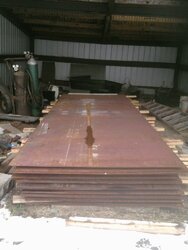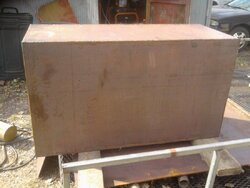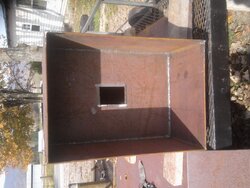Before anyone flames me for taking on such a project, please understand, I have done my homework on how these things work. I came by the steel at a very cheap price and am buying the other components as I can afford.
This project started last fall, but winter started over a month earlier compared to normal for us. I am building a gassifier that is similar to an Econoburn 150. The outside dimensions of the inner box (primary and secondary burn chambers) is already cut, welded, and pressure tested. I actually tested it to around 100 psi with an air fitting tapped into the box before doors were cut out. Sealing leaks were a pain, but it is not leaking any pressure now. It measures 18.5" wide by 26" deep by 46" tall. It is built from 1/4" A36 steel plate. I have approximately 250# of 3000 degree refractory mortar waiting to be mixed and put in this after I weld up my tubing for secondary air.
I am trying to look ahead and get ready for the outside box (water jacket). It will be made from the same 1/4" A36 plate and will be approximately 40" wide by 45.5" deep by 60" tall. This will allow a water storage area of about 11" to each side of the firebox, 1.5" to the front (excluding the doors), 18" to the back, and about 6" on the bottom and 8" to the top. From my math, the water capacity of the tank/water jacket will be somewhere around 350 gallons. The plate I am using is in 1/4" x 60" x 171" sheets. I plan to take the sheet for the outer jacket and have it bent in a brake so I can eliminate over half of the welding involved in making the tank.
My biggest concern is the water jacket capacity. I know most manufacturers are only making their boilers with 30 to 80 gallons of onboard storage where mine will have around 350. My water jacket is going to be 1/4" plate compared to most of their 1/8" plate and I will be attaching the jacket to the burn chamber with 1/2" or larger rod about every 12" to help support the added weight and pressure of the larger water box. By the time it is all said and done, the whole boiler will weigh around 2000# without water. The water will add another 2900# +/-.
Does anyone see a problem with this that I need to look for? This boiler will be going into an enclosed woodshed I have outside and will be piped to the house to be used with forced air heating.
Thanks in advance.
This project started last fall, but winter started over a month earlier compared to normal for us. I am building a gassifier that is similar to an Econoburn 150. The outside dimensions of the inner box (primary and secondary burn chambers) is already cut, welded, and pressure tested. I actually tested it to around 100 psi with an air fitting tapped into the box before doors were cut out. Sealing leaks were a pain, but it is not leaking any pressure now. It measures 18.5" wide by 26" deep by 46" tall. It is built from 1/4" A36 steel plate. I have approximately 250# of 3000 degree refractory mortar waiting to be mixed and put in this after I weld up my tubing for secondary air.
I am trying to look ahead and get ready for the outside box (water jacket). It will be made from the same 1/4" A36 plate and will be approximately 40" wide by 45.5" deep by 60" tall. This will allow a water storage area of about 11" to each side of the firebox, 1.5" to the front (excluding the doors), 18" to the back, and about 6" on the bottom and 8" to the top. From my math, the water capacity of the tank/water jacket will be somewhere around 350 gallons. The plate I am using is in 1/4" x 60" x 171" sheets. I plan to take the sheet for the outer jacket and have it bent in a brake so I can eliminate over half of the welding involved in making the tank.
My biggest concern is the water jacket capacity. I know most manufacturers are only making their boilers with 30 to 80 gallons of onboard storage where mine will have around 350. My water jacket is going to be 1/4" plate compared to most of their 1/8" plate and I will be attaching the jacket to the burn chamber with 1/2" or larger rod about every 12" to help support the added weight and pressure of the larger water box. By the time it is all said and done, the whole boiler will weigh around 2000# without water. The water will add another 2900# +/-.
Does anyone see a problem with this that I need to look for? This boiler will be going into an enclosed woodshed I have outside and will be piped to the house to be used with forced air heating.
Thanks in advance.


 :lol: Let's see 'em!
:lol: Let's see 'em!


